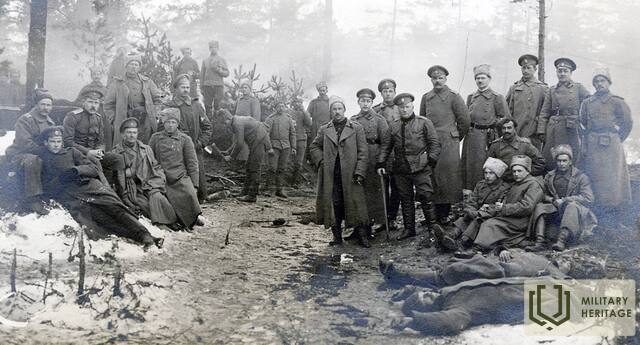Battles of Ķekava
The Battle of Kekava of 1916 was an offensive operation by the Russian Empire's 12th Army during World War I in March and July 1916 against German Army positions on the Riga Front south of Kekava. In the March battle, for the first time, two Latvian rifle battalions — the 1st Daugavgrīva Latvian Rifle Battalion and the 2nd Riga Latvian Rifle Battalion — operated together and carried out a unified attack, while in the July battles, five (also the 6th Tukums, 7th Bauska and 8th Valmiera) Latvian battalions — operated together and carried out a unified attack.
According to the staff, each battalion had 1,278 men and 4 machine guns. In fact, the battalions were even larger, as they were assigned soldiers above the staff. The battalions were armed with very accurate, but fiddly American-made "Winchester" type rifles.
The Latvian battalions learned about the upcoming attack on March 16, but on March 18 they also received the order to attack. On the morning of March 21, after a short artillery preparation, the 13th Siberian Rifle Division of the Russian 12th Army, with six Latvian rifle battalions (1st, 2nd, 5th-8th Latvian Rifle Battalions) attached to it, moved into the attack in the direction of Ķekava-Vecmuiza. Only the first two, most experienced, Latvian rifle battalions actively participated in the battles in the Bauska highway area. They were assigned to the right flank of the attack together with the 51st Siberian Rifle Regiment. For the first time, two Latvian rifle battalions fought shoulder to shoulder under the command of the commander of the second battalion, Lieutenant Colonel Jānis Frančis. Of the other Latvian battalions that remained in reserve, the 7th Bauska Latvian Rifle Battalion also received a limited task.
Both Latvian battalions attacked along the Bauska highway across an open field under enemy fire. The Siberians and Latvians managed to capture the first line of German trenches and take prisoners. After repelling the German counterattack, the riflemen also captured the second and third lines of enemy fortifications. Here the riflemen tried to strengthen themselves to repel the German attacks. When darkness fell, the battle was stopped, and the Latvian battalions returned to their starting positions. Riflemen's losses in the March battles were 704 people (of whom 265 fell and went missing). Briedis, the commander of the 1st company of the 1st Daugavgrīva Rifle Battalion, was seriously wounded in the battle (his jawbone was shattered). Lieutenant Colonel Jānis Francis described F. Briedis' perseverance in his memoirs:
"During the battle, Briedis, the commander of the 1st Company of the Daugavgrīva Rifle Battalion, was seriously wounded in the head. He came to me with the help of a medic. Blood was seeping through his head bandage. Unable to speak, Captain Briedis asked for paper and a pencil with signs; having drawn the situation of the front companies, he showed where the Germans were resisting the strongest, where help was needed, and if reinforcements were not brought, then it would not be worth sacrificing people in vain. Moreover, retreating until dusk was impossible. All the written papers were covered with his blood. With great effort, they managed to get him from the battlefield to the rear."
Without receiving additional support, the riflemen were forced to retreat to their starting positions in the evening under the cover of artillery fire. As a result of the unsuccessful combat operation, the Latvian riflemen suffered heavy losses - 262 soldiers died. The failure and the high casualties caused dissatisfaction. Kārlis Miglis expressed bitter disappointment in his memoirs: "This battle was only a demonstration - a test of strength for further combat operations. Was so much blood needed for this demonstration? Can't the enemy's forces be tested in another way?"
More information sources
https://www.sargs.lv/lv/pirmais-pasaules-kars/2015-10-26/latviesu-strelnieki-1916-gada-kaujas-pie-kekavas
https://lv.wikipedia.org/wiki/%C4%B6ekavas_kaujas
https://www.dveseluputenis.lv/lv/laika-skala/notikums/80/marta-kaujas/




